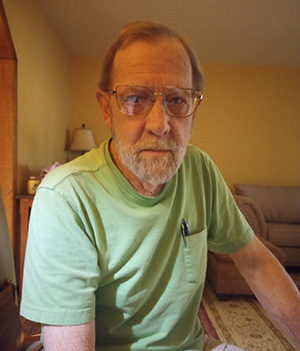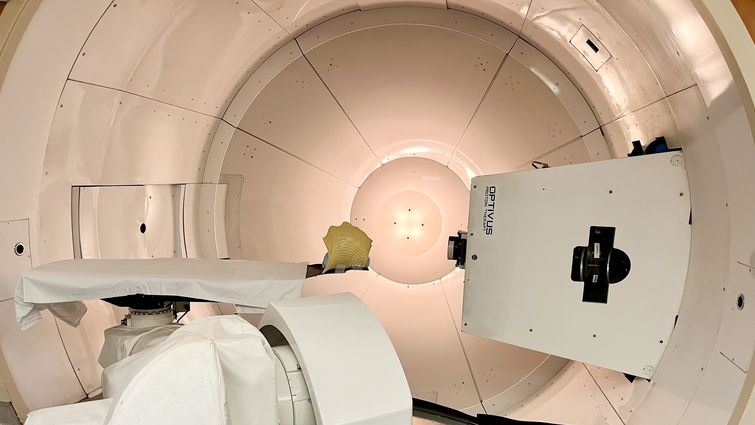

Loma Linda University Cancer Center is one of the few centers in the country to use proton beam apparatus to deliver stereotactic radiosurgery for brain tumor treatment.
A highly precise radiation therapy called stereotactic radiosurgery (SRS) treats certain types of brain tumors in patients — often in a single sitting. SRS offers a painless, one-time treatment for patients, says David Bush, MD, a radiation oncologist at Loma Linda University Cancer Center. In addition, the radiation’s targeted focus on tumors causes less damage to patients’ surrounding healthy brain tissue.
“This technology safely delivers a concentrated dose of radiation in a highly precise way, targeting tumors in the brain and rendering them inactive,” says Bush. “Compared to other cancer-related treatments requiring several rounds or cycles, patients tend to appreciate receiving SRS in a single session,” says Bush.
For May’s Brain Tumor Awareness Month, Bush explains SRS and its various benefits for patients.
Using 3-D-computerized imaging, SRS aims radiation beams at abnormal tissues in the brain, distorting and destroying tumor cells’ DNA so they lose the ability to grow or reproduce. Bush says optimal treatment deactivates the tumor so that it gradually shrinks over time.
Bush says no current evidence indicates SRS effectively treats primary malignant brain tumors (cancerous tumors originating in the brain) such as glioblastoma or gliomas. Evidence does, however, show SRS to be highly effective in treating:
- Primary brain tumors that are benign (non-cancerous) and cannot easily be removed through surgery, including meningiomas, pituitary adenomas, and acoustic neuromas
- Brain metastasis or secondary brain tumors — cancer that originates in other parts of the body and spreads to the brain
SRS proves highly safe and successful in targeting one or a few small brain tumors at a time, says Bush — no larger than three centimeters, roughly the size of a peanut or grape.
“A size limitation for SRS exists because the larger the tumor, the larger the radiation field needed, and hence the more likely it is for normal brain tissue to receive unnecessary radiation,” Bush says. “We want to minimize damage to surrounding non-tumor tissues as much as possible in the brain.”
Bush says several reasons explain why SRS offers the best option for many patients with brain tumors. First, as benign brain tumors grow, they push on surrounding tissue, which can cause neurological problems and symptoms. Additionally, Bush says many tumors in the brain aren’t surgically accessible because of its many intricate and sensitive surrounding structures. Finally, he adds that medical interventions such as chemotherapy or systemic therapies don't effectively treat benign brain tumors or brain metastases.

Thomas Ray
“Here I am today,” says Thomas Ray, 73, who underwent SRS for his brain metastasis in April. Ray partnered with his oncologist and Bush to address the lung cancer that had spread to his brain. "Other than the machine being noisy, I felt no pain during the radiation, and I was glad to have only to get it once."
Healthcare experts can utilize various types of equipment to deliver SRS. For example, Bush says LLU Cancer Center is one of the few centers in the country to use proton beam apparatus for SRS delivery — a tool with several advantages.
Typically, SRS involves aiming dozens of X-ray beams at a tumor; since X-rays travel all the way through the brain at numerous angles, they can deliver some low-dose radiation to other parts of the brain with normal tissue. However, the proton beam’s physical properties allow Bush and experts to “shape the beams,” he says, and use only three to four beams to minimize the amount of normal brain exposed to low-dose radiation.
A team of specialists, including dosimetrists, physicists, technicians, neurosurgeons, and physicians, perform and analyze the patients’ imaging, using results to craft a meticulous plan for targeting specific tumors.
“The team will use imaging to develop a treatment plan that considers which angles are optimal for aiming proton beams and what important structures to avoid like eyes, nerves, and brain parts," Bush says.
Due to the high precision of SRS delivered with proton beams, Bush says patients must remain extremely still to allow the beams to focus on their tumors. A custom-made bite block connected to a table helps patients hold as still as possible for the duration of the procedure — no more than an hour.
Ray has been steadily recovering from SRS and other treatments associated with his cancer and says he lives life one day at a time. As he feels better daily, he says he plans to travel around national parks with his wife, including Yosemite and the Redwood.
At Loma Linda University Cancer Center, physicians care deeply about the outcome and medical journey of a patient diagnosed with cancer. To learn more about the services offered to patients at the Cancer Center, visit lluh.org/cancer-center or call 1-800-782-2623 to make an appointment.


